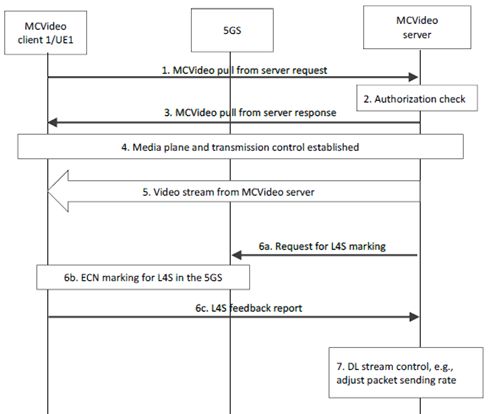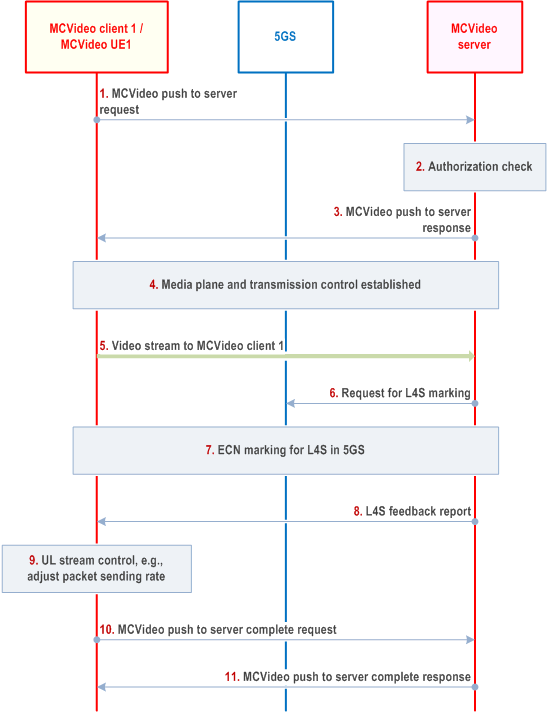Content for TS 23.289 Word version: 19.4.0
0…
4…
4.7…
4.7.4…
4.8…
5…
5.4…
6…
6.3…
6.3.2…
7…
7.2.4…
7.3…
7.3.3…
7.3.3.2…
7.3.3.4…
7.3.3.5…
7.3.3.7…
7.3.3.8…
7.3.3.9…
7.3.3.10…
7.3.3.11…
7.3.3.12…
7.3.3.13…
7.4…
7.5…
7.6…
A…
7.6 MC service over 5G ProSe
7.6.1 Off network group communication for MC service
7.6.2 Off-network private communication
7.6.3 Use of 5G ProSe UE-to-network relay
7.6.3.1 5G ProSe UE-to-network relay service authorization
7.6.3.2 UE-to-network relay MC service
7.7 MCVideo enhancement with ECN marking for L4S
7.6 MC service over 5G ProSe |R18| p. 104
7.6.1 Off network group communication for MC service p. 104
The procedures and information flows used in TS 23.280, TS 23.379, TS 23.281, and TS 23.282 are reused for Off network group communication for MC service over 5G ProSe with following differences:
- Discovery Group ID is replaced by Application Layer Group ID, as specified in TS 23.304.
- The ProSe Layer-2 Group ID of the target MC service group may be used by the ProSe layer as the target group info;
- The Groupcast mode 5G ProSe Direct Communication procedure in clause 6.4.2 of TS 23.304 is utilized for the establishment of off-network group communication and the following media plane traffic exchanges.
7.6.2 Off-network private communication p. 105
The procedures and information flows used in TS 23.280, TS 23.379, TS 23.281, and TS 23.282 are reused for off-network private communication for MC service over 5G ProSe with following differences:
- PPPP (ProSe Per-Packet Priority) is replaced with PQI, as specified in TS 23.304.
- The ProSe discovery group ID is replaced with Application layer group ID which identifies a discovery group as specified in TS 23.304. The Application layer group ID and the user info ID of the target MC service user are provisioned to the MC service client in the MC service user profile. The MC service client enables the ProSe layer to determine the IP address for the communication with the target MC service user by providing the Application layer group ID and user info ID of the target MC service user.
- Group Member Discovery procedure in TS 23.304 is utilized to enable for the call initiator to determine whether the called MC service user is in the proximity of the calling user prior to the establishment of an off-network private communication.
- The Unicast mode 5G ProSe Direct Communication procedure in TS 23.304 is utilized for the establishment of off-network private communication and the following media plane traffic exchanges.
7.6.3 Use of 5G ProSe UE-to-network relay p. 105
7.6.3.1 5G ProSe UE-to-network relay service authorization p. 105
The MC service shall support the capability for 5G ProSe UE-to-network relay to restrict the relayed group communication on a per group basis by using the relay service codes corresponding to the group.
5G ProSe (as specified in TS 23.304) supports layer 2 UE-to-network relay and layer 3 UE-to-network relay. The procedure defined in clause 10.5 of TS 23.280 applies with the following differences:
- 5G ProSe UE-to-network relay is provisioned that each relay service code is offering layer 2 or layer 3 UE-to-Network Relay service.
- 5G ProSe remote UE is provisioned that each relay service code is offering layer 2 or layer 3 UE-to-Network Relay service.
- 5G ProSe Layer-3 UE-to-network relay is provisioned with suitable relay service codes to support access to N3IWF for the case of 5G ProSe Layer-3 UE-to-network relay with the support of N3IWF.
7.6.3.2 UE-to-network relay MC service p. 105
The 5G ProSe UE-to-network relay provides a layer 2 or layer 3 routing service (as specified in TS 23.304) for a 5G ProSe remote UE, when the MC service user on the 5G ProSe remote UE requires to access the MC service via a 5G ProSe UE-to-network relay.
The application layer signalling for the MC service user on a 5G ProSe remote UE using a 5G ProSe UE-to-network relay are identical to the application layer signalling for the MC service user on an on-network UE.
7.7 MCVideo enhancement with ECN marking for L4S |R19| p. 106
7.7.1 General p. 106
These clauses specify the procedure for the MCVideo communication (e.g., video pull from server) enhancement with ECN marking for L4S (L4S is defined in RFC 9330).
7.7.2 Information flows p. 106
7.7.2.1 L4S feedback report p. 106
Table 7.7.2.1-1 defines the L4S feedback report from MCVideo client to MCVideo server to provide DL L4S feedback information, and from the MCVideo server to the MCVideo client to provide UL L4S feedback information.
| Information element | Status | Description |
|---|---|---|
| MCVideo ID | M | Identity of the MCVideo user. |
| Media identifier | O | Identifies the communication, e.g. by identifying the media flow within a media multiplex, present only if media multiplexing. |
| L4S information | M | The L4S ECN information reported related to DL congestion if it is sent from the MCVideo client to the MCVideo server, or related to the UL congestion if it is sent from the MCVideo server to the MCVideo client. |
7.7.3 Procedures p. 106
7.7.3.1 One-from-server video pull enhancement p. 106
Procedure in Figure 7.7.3.1-1 is the common signalling control plane procedures for the MCVideo communication enhancement with ECN marking for L4S capability.
Pre-condition:
- The MCVideo server has already obtained the L4S handling capability from the MCVideo client 1.

Step 1-5.
Same as step 1 to step 5 in clause 7.3.2.4.2 of TS 23.281.
Step 6a.
The MCVideo server may determine to utilize the 5GS L4S capabilities to obtain the congestion information to improve the downlink stream transmission control. The MCVideo server interacts with the 5GS to request the ECN marking for L4S as specified in TS 23.502.
Step 6b.
The 5GS starts to perform the ECN marking as specified in TS 23.501. The MCVideo UE receives the DL media stream with ECN marking in the IP header which reflects the DL network congestion status.
Step 6c.
The MCVideo client, based on the DL ECN marking in the IP header, generates and sends the L4S feedback report towards the MCVideo server as described in RFC 9330.
Step 7.
The MCVideo server, based on step 6b performs the DL media stream control, e.g., adjust the DL media packet sending rate.
Step 8.-9.
Step 8 and step 9 are same as step 6 and step 7 of clause 7.3.2.4.2 of TS 23.281, respectively.
7.7.3.2 One-to-server- video push enhancement p. 107
Figure 7.7.3.2-1 describes a common signalling control plane procedure for MC video client initiating the establishment of video push where the push feature is enhanced via ECN marking for L4S capability.
Precondition:
- The MCVideo server has already obtained the L4S handling capability from the MCVideo client 1.

Step 1.-5.
Same as steps 1 to step 5 of clause 7.4.2.4.2 of TS 23.281.
Step 6.
The MCVideo server may determine to utilize the 5GS L4S capability to obtain the congestion information to improve the UL stream transmission control. For this purpose, the MCVideo server interacts with the 5GS to request the ECN marking for L4S as specified in TS 23.502.
Step 7.
The 5GS starts to perform the ECN marking as specified in TS 23.501. The 5GS receives the UL media stream with ECN marking in the IP header which reflects the UL network congestion status. The 5GS exposes the congestion information to the MCVideo server as specified in TS 23.501.
Step 8.
Based on the UL ECN marking in the IP header, the MCVideo server generates and sends the L4S feedback report towards the MCVideo client as described in RFC 9330.
Step 9.
Based on the L4S feedback report, the MCVideo performs UL stream control, e.g., adjust the UL media packet sending rate.
Step 10.-11.
Step 10 and step 11 are same as step 6 and step 7 of clause 7.4.2.4.2 of TS 23.281, respectively.